Related Research Articles
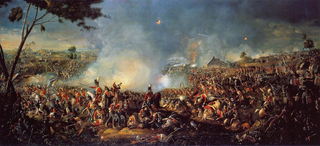
The Battle of Waterloo was fought on Sunday 18 June 1815, near Waterloo, marking the end of the Napoleonic Wars. A French army under the command of Napoleon was defeated by two armies of the Seventh Coalition. One of these was a British-led force with units from the United Kingdom, the Netherlands, Hanover, Brunswick, and Nassau, under the command of the Duke of Wellington. The other comprised three corps of the Prussian army under Field Marshal von Blücher. The battle was known contemporarily as the Battle of Mont Saint-Jean in France or La Belle Alliance in Prussia.
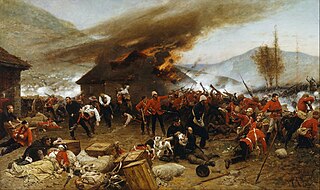
The Battle of Rorke's Drift, also known as the Defence of Rorke's Drift, was an engagement in the Anglo-Zulu War. The successful British defence of the mission station of Rorke's Drift, under the command of Lieutenants John Chard of the Royal Engineers and Gonville Bromhead, of the 24th Regiment of Foot began when a large contingent of Zulu warriors broke off from the main force during the final hour of the British defeat at the day-long Battle of Isandlwana on 22 January 1879, diverting 6 miles (9.7 km) to attack Rorke's Drift later that day and continuing into the following day.

General Sir James Kempt, was a British Army officer, who served in the Netherlands, Egypt, Italy, the Peninsula, and British North America during the Napoleonic Wars. He led a British brigade at the Battle of Waterloo and later became Governor General of Canada.
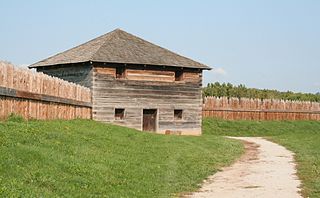
The siege of Fort Meigs took place in late April to early May 1813 during the War of 1812 in northwestern Ohio, present-day Perrysburg. A small British Army unit with support from Indians attempted to capture the recently constructed fort to forestall an American offensive against Detroit, and its Fort Detroit in the Great Lakes region which the British from the north in Canada had captured the previous year. An American sortie and relief attempt failed with heavy casualties, but the British failed to capture the fort and were forced to raise the siege.

The 33rd Virginia Infantry Regiment was an infantry regiment raised in the Commonwealth of Virginia for service in the Confederate States Army during the American Civil War. It was a part of the famed "Stonewall Brigade," named for General Stonewall Jackson.
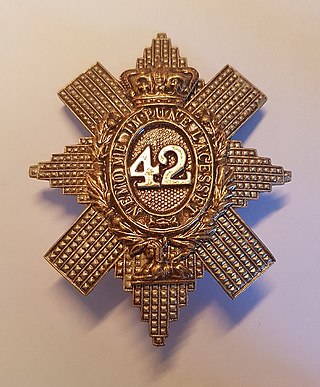
The 42nd Regiment of Foot was a Scottish infantry regiment in the British Army also known as the Black Watch. Originally titled Crawford's Highlanders or the Highland Regiment and numbered 43rd in the line, in 1748, on the disbanding of Oglethorpe's Regiment of Foot, they were renumbered 42nd, and in 1751 formally titled the 42nd (Highland) Regiment of Foot. The 42nd Regiment was one of the first three Highland Regiments to fight in North America. The unit was honoured with the name Royal Highland Regiment in 1758. It's informal name Black Watch became official in 1861. In 1881, the regiment was amalgamated with another unit under the Childers Reforms into The Royal Highland Regiment , being officially redesignated The Black Watch in 1931. In 2006, the Black Watch became part of the Royal Regiment of Scotland.

The 11th Infantry Regiment is a regiment in the United States Army. In 2007, the 11th Infantry was reflagged as the 199th Infantry Brigade, as part of the "Transformation of the US Army" effort. Today, the 11th Infantry Regiment is part of the Army's regimental system and is the primary regiment to which many Infantry School units are aligned.

Major-General Sir Guy Campbell, 1st Baronet, was a British Army officer, the eldest son of Lieutenant-General Colin Campbell and his wife Mary, daughter of Guy Johnson. His branch of the Campbell baronets is referred to as St Cross Mede.

The Duchess of Richmond's Ball was a ball hosted by Charlotte, Duchess of Richmond in Brussels on 15 June 1815, the night before the Battle of Quatre Bras. Charlotte's husband Charles Lennox, 4th Duke of Richmond, was in command of a reserve force in Brussels, which was protecting that city in case Napoleon Bonaparte invaded.
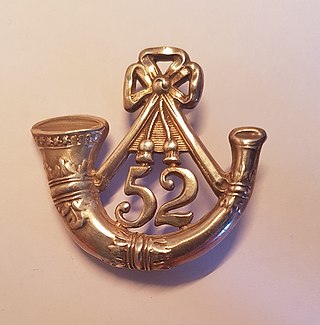
The 52nd (Oxfordshire) Regiment of Foot was a light infantry regiment of the British Army throughout much of the 18th and 19th centuries. The regiment first saw active service during the American War of Independence, and were posted to India during the Anglo-Mysore Wars. During the Napoleonic Wars, the 52nd were part of the Light Division, and were present at most major battles of the Peninsula campaign, becoming one of the most celebrated regiments, described by Sir William Napier as "a regiment never surpassed in arms since arms were first borne by men". They had the largest British battalion at Waterloo, 1815, where they formed part of the final charge against Napoleon's Imperial Guard. They were also involved in various campaigns in India.
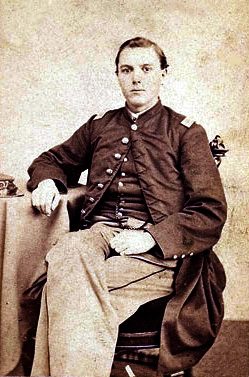
John Gregory Bishop Adams was an American soldier who received the Medal of Honor for his actions during the American Civil War.

General Sir John Lambert was a British Army officer who served in the French Revolutionary Wars, the Napoleonic Wars and the War of 1812. He is best known for his consummate actions whilst commanding the tenth brigade during the Battle of Waterloo, which kept open the vital line of communication between Hougoumont farmhouse and the rest of the Allied army.

The 24th Ohio Infantry Regiment was an infantry regiment in the Union Army during the American Civil War. The regiment was known for its daring and professional behavior, often arriving first into the battle and acting as the vanguard in its brigade. In its first battle, the 24th Ohio and the 14th Indiana, with around 300 soldiers fit for duty, defended the Cheat Mountain Summit Fort from around 4,500 Rebels in Anderson's Brigade, Rust's Brigade, and Gen. H. R. Jackson's brigade, leading to a disastrous defeat for Confederate General Robert E. Lee. The regiment played "The Star-Spangled Banner" during the Battle of Shiloh, and lost almost all of its commissioned officers in the Battle of Stones River. The 24th Ohio suffered its only defeat on the battlefield at the Battle of Chickamauga.

General Sir Andrew Francis Barnard was an Irish British Army officer. He served in various capacities in the West Indies, the Cape of Good Hope, Canada, the Netherlands, Sicily, Spain and in the Napoleonic Wars including the Battle of Waterloo for which service he was highly decorated. After his retirement from active duty, he served in a number of civilian positions, being promoted to general four years before his death.
Lieutenant-General Sir James Frederick Lyon was a distinguished officer of the British Army who served as Governor of Barbados from 1829 to 1833.
Sir William Henry Elliott, was a British Army general.

The 19th (Dawson's) Arkansas Infantry (1861–1865) was a Confederate Army infantry regiment during the American Civil War. The regiment was present for but not engaged during the Battle of Pea Ridge. At the Battle of Arkansas Post, the regiment became split, with part of the regiment surrendering with the garrison when the post capitulated. The captured portion of the regiment was eventually exchanged and released on the east side of the Mississippi and served the remainder of the war with the Confederate Army of Tennessee. The un-captured portion of the regiment was consolidated with the remnants of the 24th Arkansas and served the remainder of the war in the Department of the Trans-Mississippi.

Antoine Maurin commanded a French cavalry division in 1814 during the Napoleonic Wars and in 1815 led his troops against the Prussians at Ligny where he was wounded. His army service began in 1792 during the French Revolution when he enlisted in a cavalry regiment as a trooper. He spent his entire military career as a cavalryman. During the French Revolutionary Wars he advanced through the ranks and became commander of a light cavalry regiment in 1802. While only a colonel, he commanded a brigade at Caldiero in October 1805. He fought in the Friedland campaign in 1807 and attained the rank of general officer that year. As a cavalry brigadier, he participated in the 1807 Invasion of Portugal but was captured in 1808 and held until 1812. He led a brigade in 1813 and a division in 1814 during the War of the Sixth Coalition. After fighting for Napoleon during the Hundred Days, he retired in 1823. His surname is one of the names inscribed under the Arc de Triomphe, on Column 40.
Sir Robert Chambre Hill CB was a British Army cavalry officer who fought in the Peninsular War and was wounded while in command of the Royal Horse Guards at the Battle of Waterloo on 18 June 1815.

The 24th and 25th Consolidated Texas Cavalry Regiment was a unit that originally consisted of two regiments of mounted volunteers that served in the Confederate States Army during the American Civil War. However, by the time the two regiments were consolidated, they fought as infantry. Both regiments organized as cavalry near Hempstead, Texas in April 1862 and were dismounted to fight as infantry in July 1862. The two regiments served in the same brigade and were captured at the Battle of Arkansas Post in January 1863. After being sent to Northern prison camps, the soldiers were exchanged in April 1863. Assigned to the Army of Tennessee, the two regiments were consolidated with two additional Texas cavalry regiments and in 1863 fought as infantry at Liberty Gap, Chickamauga, Missionary Ridge, and Ringgold Gap. In 1864, the other two Texas regiments were detached and the consolidated 24th and 25th fought as a separate infantry unit in the Atlanta campaign, at Franklin, and at Nashville. For the Carolinas campaign, the 24th and 25th fought at Bentonville before being reconsolidated with other Texas regiments and surrendering in April 1865.
References
- Hart, H. G. 1841. The New Army List.
- Paton, G. 1892. Historical Records of the 24th Regiment. London.